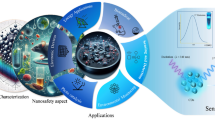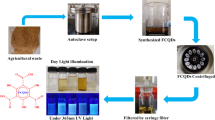Abstract
Polystyrene nanofibers were coated with copper nanoparticles (CuNPs) by a combination of electrospinning and in-situ reduction of Cu(II) using sodium borohydride as the reductant. The CuNPs on the nanofibers were characterized by energy dispersive spectrometry, scanning electron microscopy and transmission electron microscopy. A cartridge was packed with the nanofibers which then were activated with methanol and water. Glutathione (GSH) is found to quantitatively adsorbed by the packed cartridge at pH 3.0, and then can be desorbed with aqueous 2-mercaptoethanol and detected, after derivatization with ortho-phthalaldehyde, via high performance liquid chromatography with fluorometric detection. Under optimized conditions, the method has a 1.1 ng·mL−1 detection limit and a response that is linear in the 10–1000 ng·mL−1 GSH concentration range. The recoveries of GSH from artificial urine spiked at three levels (80, 400 and 800 ng·mL−1) are in the range of 94.6–98.6% with relative standard deviations (RSD) of <4.5% (n = 5). The method was applied to assessing the differences in urinary GSH between high-risk infants and healthy infants. The results show that the levels of GSH of normal infants are significantly higher than those of high-risk infants (P < 0.05).

Schematic of the preparation of CuNP-assembled nanofibers and the mechanism of extracting glutathione (GSH). GSH can be extracted by this material based on a strong interaction between the sorbent and GSH. This is attributed to the formation of Cu-S bonds between Cu and -SH.









Similar content being viewed by others
References
Anderson ME (1998) Glutathione: an overview of biosynthesis and modulation. Chem Biol Interact 111:1–14
Lund MJ, Trivers KF, Porter PL, Coates RJ, Jones BL, Brawley OW, Flagg EW, O’Regan RM, Gabram SGA, Eley JW (2009) Race and triple negative threats to breast cancer survival: a population-based study in Atlanta GA. Breast Cancer Res Treat 113:357–370
Küster A, Tea I, Roucher VF, Borgne SL, Plouzennec C, Winer N, Rozé JC, Robins RJ, Darmaun D (2011) Cord blood glutathione depletion in preterm infants: correlation with maternal cysteine depletion. PLoS One 6(11):e27626
Svardal AM, Mansoor MA, Ueland PM (1990) Determination of reduced, oxidized, and protein-bound glutathione in human plasma with precolumn derivatization with monobromobimane and liquid chromatography. Anal Biochem 184:338–346
Mansoor MA, Svardal AM, Ueland PM (1992) Determination of the in vivo redox status of cysteine, cysteinylglycine, homocysteine, and glutathione in human plasma. Anal Biochem 200:218–229
Zacharis CK, Tzanavaras PD, Zotou A (2011) Ethyl propiolate as a post-column derivatization reagent for thiols: development of a green liquid chromatographic method for the determination of glutathione in vegetables. Anal Chim Acta 690:122–128
Zacharis CK, Tzanavaras PD, Karakosta TD, Themelis DG (2013) Zwitterionic hydrophilic interaction chromatography coupled with post-column derivatization for the analysis of glutathione in wine samples. Anal Chim Acta 795:75–81
Huang KJ, Han CH, Sun JY, Niu DJ, Wu ZW, Xue YP, Zhang LJ, Xiong XQ (2010) Sensitive determination of thiols using SPE coupled to LC with fluorescence detection. Chromatographia 72:1049–1054
Rajeshwari A, Garg K, Elavarasi M, Chandrasekaran N, Mukherjee A (2017) Interaction of citrate-capped gold nanoparticles with the selected amino thiols for sensing applications. Proc Natl Acad Sci India Sect B: Biol Sci 87:23–30
Ji DY, Meng HG, Ge J, Zhang L, Wang HQ, Bai DG, Li JJ, Qu LB, Li ZH (2017) Ultrasensitive fluorometric glutathione assay based on a conformational switch of a G-quadruplex mediated by silver (I). Microchim Acta 184:3325–3332
Wang ZX, Ding SN, Jomma Narjh EY (2015) Determination of thiols by fluorescence using au@ ag nanoclusters as probes. Anal Lett 48:647–658
Cao H, Chen Z, Huang Y (2015) Copper nanocluster coupling europium as an off-to-on fluorescence probe for the determination of phosphate ion in water samples. Talanta 143:450–456
Li H, Li C, Bai J, Zhang CG, Sun WY (2014) Carbon nanofiber supported copper nanoparticles catalyzed Ullmann-type coupling reactions under ligand-free conditions. RSC Adv 4:48362–48367
Chen J, Teo KC (2001) Determination of cadmium, copper, lead and zinc in water samples by flame atomic absorption spectrometry after cloud point extraction. Anal Chim Acta 450:215–222
Mudabuka B, Ondigo D, Degni S, Vilakazi S, Torto N (2014) A colorimetric probe for ascorbic acid based on copper-gold nanoparticles in electrospun nylon. Microchim Acta 181:395–401
Zhao R, Chu L, Wang Y, Song Y, Liu P, Li C, Huang JJ, Kang XJ (2017) Application of packed-fiber solid-phase extraction coupled with GC-MS for the determination of short-chain fatty acids in children's urine. Clin Chim Acta 468:120–125
Michaelsen JT, Dehnert S, Giustarini D, Beckmanna B, Tsikasa D (2009) HPLC analysis of human erythrocytic glutathione forms using OPA and N-acetyl-cysteine ethyl ester: evidence for nitrite-induced GSH oxidation to GSSG. J Chromatogr B 877:3405–3417
Chen LQ, Wang Y, Qu JS, Deng JJ, Kang XJ (2015) Selective extraction of catecholamines by packed fiber solid-phase using composite nanofibers composing of polymeric crown ether with polystyrene. Biomed Chromatogr 29:103–109
Tan Q, Zhang R, Kong R, Kong W, Zhao W, Qu F (2018) Detection of glutathione based on MnO 2 nanosheet-gated mesoporous silica nanoparticles and target induced release of glucose measured with a portable glucose meter. Microchim Acta 185:44
Yang R, Guo X, Jia L, Zhang Y (2017) A fluorescent bon-off-on assay for selective recognition of cu (II) and glutathione based on modified carbon nanodots, and its application to cellular imaging. Microchim Acta 184:1143–1150
Guo Y, Yang L, Li W, Wang X, Shang Y, Li B (2016) Carbon dots doped with nitrogen and sulfur and loaded with copper (II) as a "turn-on" fluorescent probe for cystein, glutathione and homocysteine. Microchim Acta 183(4):1409–1416
Chang CW, Tseng WL (2010) Gold nanoparticle extraction followed by capillary electrophoresis to determine the total, free, and protein-bound aminothiols in plasma. Anal Chem 82:2696–2702
Zhang WB, Li PL, Geng QQ, Duan YH, Guo MC, Cao YS (2014) Simultaneous determination of glutathione, cysteine, homocysteine, and cysteinylglycine in biological fluids by ion-pairing high-performance liquid chromatography coupled with precolumn derivatization. J Agric Food Chem 62:5845–5852
Miranda LP, Resegue R, Figueiras ACM (2003) Children and adolescents with developmental disabilities in the pediatric outpatient clinic. J Pediatr 79:S33–S42
Saugstad OD (2003) Bronchopulmonary dysplasia oxidative stress and antioxidants. Semin Fetal Neonatal Med 8:39–49
Ghanizadeh A, Akhondzadeh S, Hormozi M, Makarem A, Zarchi MA, Firoozabadi (2012) A glutathione-related factors and oxidative stress in autism, a review. Curr Med Chem 19:4000–4005
Acknowledgments
This study was supported by the National Science Foundation of China (No. 81172720, No. 81673230); the Social Development Research Program of Jiangsu Province Science and Technology department (No. BE2016741); and the Postgraduate Research & Practice Innovation Program of Jiangsu Province (No. KYCX17_0189).
Author information
Authors and Affiliations
Corresponding author
Ethics declarations
The author(s) declare that they have no competing interests.
Electronic supplementary material
ESM 1
(PDF 1.05 mb)
Rights and permissions
About this article
Cite this article
Wei, L., Song, Y., Liu, P. et al. Polystyrene nanofibers capped with copper nanoparticles for selective extraction of glutathione prior to its determination by HPLC. Microchim Acta 185, 321 (2018). https://doi.org/10.1007/s00604-018-2845-z
Received:
Accepted:
Published:
DOI: https://doi.org/10.1007/s00604-018-2845-z




